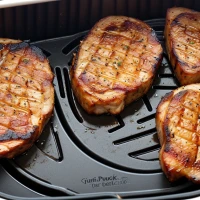Embark on a journey to the heart of Italian culinary tradition with this deep dive into the art of creating authentic Cacio e Pepe. This beloved Roman pasta dish, celebrated for its simplicity and rich flavors, has enamored food enthusiasts for generations. The secret to perfect Cacio e Pepe lies not just in its ingredients but in the age-old techniques that transform humble staples into a gastronomic spectacle. In this comprehensive guide, we’ll unpack the quintessence of this dish, offer insights into selecting the right ingredients, and serve up an authentic Cacio e Pepe recipe that promises to tantalize your taste buds and elevate your cooking prowess.
Cacio e Pepe, which literally translates to “cheese and pepper,” is a testament to the beauty of minimalist cooking. With only a few ingredients, this dish showcases how precision, patience, and a touch of culinary finesse can yield a flavor profile that’s deceptively complex and unmistakably satisfying. This article is a treasure trove for both the amateur cook and the seasoned chef aiming to perfect their Cacio e Pepe recipe authentic experience. So tie on your apron, ready your pots, and prepare to unlock the full potential of this timeless Vegetable-themed classic.
A Brief History of Cacio e Pepe
The Roman Roots
Cacio e Pepe holds a special place in the pantheon of Italian cuisine. It’s a dish steeped in history, hailing from the pastoral landscapes of ancient Rome where shepherds valued foods that were nourishing, long-lasting, and easy caprese chicken saltimbocca recipe to carry. Pecorino Romano (sheep’s cheese) and black pepper, both staples among shepherd’s provisions, serve as the primary ingredients.
From Humble Beginnings to Culinary Stardom
What began as a pragmatic meal for shepherds evolved into a quintessential Roman favorite, gracing the tables of both trattorias and fine dining establishments. The beauty of Cacio e Pepe emerged from the simplicity it was rooted in; an authentic reflection of the rustic, Italian way of life.
The Anatomy of Authentic Cacio e Pepe
The Holy Trinity: Pecorino, Pepper, and Pasta
At its core, authentic Cacio e Pepe consists of just three ingredients, each playing an integral role in the overall symphony of flavors:
- Pecorino Romano: This tangy, salty cheese creates the luscious creamy sauce.
- Freshly Cracked Black Pepper: Pungent and aromatic, it elevates the dish with a warm bite.
- Pasta: Traditionally, tonnarelli, a thick spaghetti-like pasta, is used for its ability to hold onto the cheese and pepper.
The Mastery of Technique
The magic in Cacio e Pepe is not just about what you put in it, but how it all comes together. Melting the cheese to the right consistency and emulsifying the pasta cooking water into the mix are crucial steps. Achieving this requires timing and skill, and it’s here that many attempts can go awry, resulting in clumps or a greasy brussel sprouts recipe sauce.
The Authentic Cacio e Pepe Recipe
Step-by-Step: Crafting the Perfect Dish
-
Ingredients:
- 200 grams (7 ounces) of tonnarelli or spaghetti
- 150 grams (5 ounces) of grated Pecorino Romano
- Freshly cracked black pepper to taste
- Salt for the pasta water
-
Instructions:
- Start by bringing a large pot of water to a rolling boil. Add a pinch of salt.
- Add the pasta and cook until al dente, following the packet’s instructions.
- While the pasta cooks, toast the black pepper in a large pan over medium heat for 1-2 minutes until aromatic.
- Ladle some pasta water into the pan with the pepper and stir to create a thick, pepper-infused liquid.
- Drain the pasta, reserving a cup of the cooking water.
- Add the pasta to the pan with the pepper-water mixture, tossing to coat evenly.
- Remove the pan from the heat, add the Pecorino Romano slowly, and toss vigorously with the pasta water to create a creamy sauce. Utilize additional pasta water as needed to achieve the right consistency.
- Serve immediately, garnished with extra Pecorino and a sprinkle of black pepper.
Pro Tips to Ensure Authenticity
- Use high-quality Pecorino Romano; its flavor is unmatched.
- Freshly crack the black pepper to preserve its essential oils and piquancy.
- Avoid using oil or butter; the creamy texture should come solely from cheese emulsified with pasta water.
Selecting the Right Ingredients
Pecorino Romano: The Star
deep purple - acai bowlsThe selection of Pecorino Romano cheese is critical. Authentic Cacio e Pepe demands this cheese for its sharp, salty punch and its unrivaled melting characteristics.
Pasta: The Perfect Canvas
While tonnarelli is traditional for Cacio e Pepe, high-quality spaghetti can be a good substitute. The key is to choose pasta with a rough texture to grab onto the sauce adequately.
Black Pepper: The Essential Spice
Do not underestimate the importance of black pepper. Freshly ground black pepper is essential as it provides a bold depth of flavor that pre-ground pepper simply cannot match.
The Science Behind the Perfect Cacio e Pepe
The Role of Starches
The starch released from the pasta durreheat pork chops in air fryerg cooking is the secret that binds the dish together, acting as an emulsifier for the water and cheese, ensuring a silky, clump-free sauce.
The Importance of Tempering
Adding the cheese to just the right temperature prevents it from becoming gritty or oily. The pasta should be hot enough to melt the cheese but not so hot that it causes the fats to separate.
Achieving the Silky Texture
The correct consistency of the sauce is paramount. It should be fluid, but thick enough to coat each strand of pasta. This balance is achieved through controlled addition and evaporation of the pasta water.
Pairing Cacio e Pepe with the Right Beverage
Wine Pairings
A crisp white wine, such as Frascati, with its light minerality and acidity, complements the saltiness and richness of the dish, while a medium-bodied red can stand up to the boldness of pepper.
Alternative Pairings
For non-alcoholic options, a sparkling water with a twist of lemon offers a refreshing contrast, and for those looking for something more indulgent, a creamy cappuccino can serve as a unique and comforting match.
Serving and Presentation
The Art of Plating
Present your Cacio e Pepe lovingly twirled on a pre-warmed plate, adorned with a final grating of Pecorino and a turn of the pepper mill. Remember, the dish’s elegance lies in its simplicity.
Accompaniments
Cacio e Pepe is best enjoyed as a standalone masterpiece. However, a side of bitter greens or a simple arugula salad can provide a crisp counterpoint to the richness of the pasta.
Preservation and Leftovers
Storing the Leftovers
Cacio e Pepe is best consumed fresh, however, if needed, leftovers can be stored in an airtight container in the fridge for a day.
Reheating Tips
If reheating is necessary, do so gently in a pan, adding a splash of water to revive the sauce, taking great care not to overheat the cheese thereby ensuring your leftovers retain their magic.
Crafting the Perfect Cacio e Pepe: Takeaways
The Zen of Simplicity
The understated elegance of Cacio e Pepe is a culinary meditation on minimalism, where the focus on quality ingredients and masterful technique yields an astounding result.
The Ritual of Practice
Achieving the ideal Cacio e Pepe is a dance that demands both discipline and creativity. It requires resolving to respect the roots of the recipe, while also embracing the subtle nuances that come with individual touch.
The Journey of Taste
Ultimately, the journey to the perfect Cacio e Pepe is an exploration of taste, a venture into the heart of Italy’s culinary soul that rewards the tenacious cook with each steaming, savory twirl.
Infusing your taste tests with passion, patience, and a reverence for the dish’s authentic heritage will ensure that your Cacio e Pepe recipe authentic efforts rise to the top of any gourmet quest. As you refine your culinary chops, remember that Cacio e Pepe isn’t just a recipe—it’s a story of Rome, a tale spun in cheese and pepper, waiting to be retold on plates around the world. Buon appetito!










